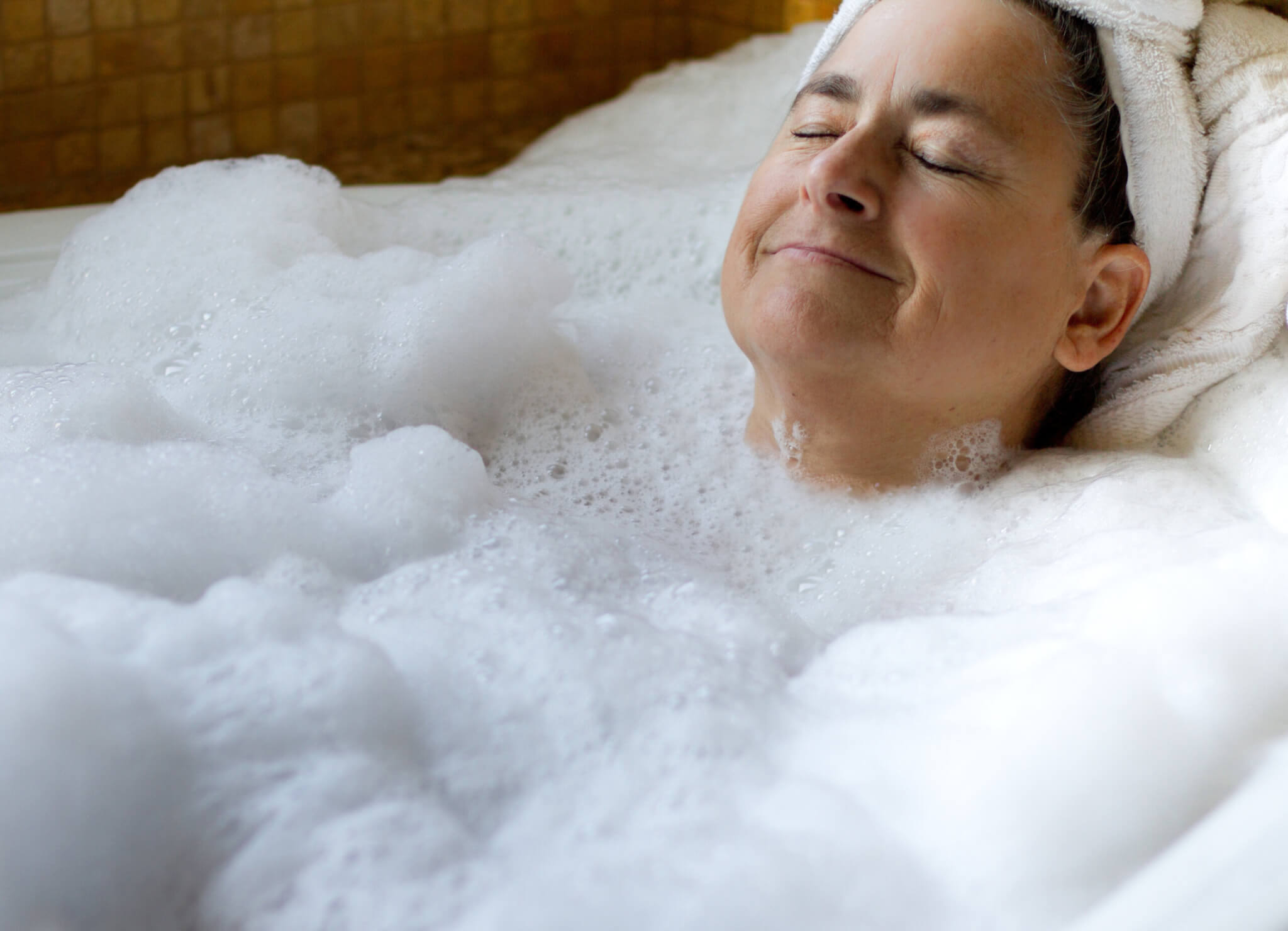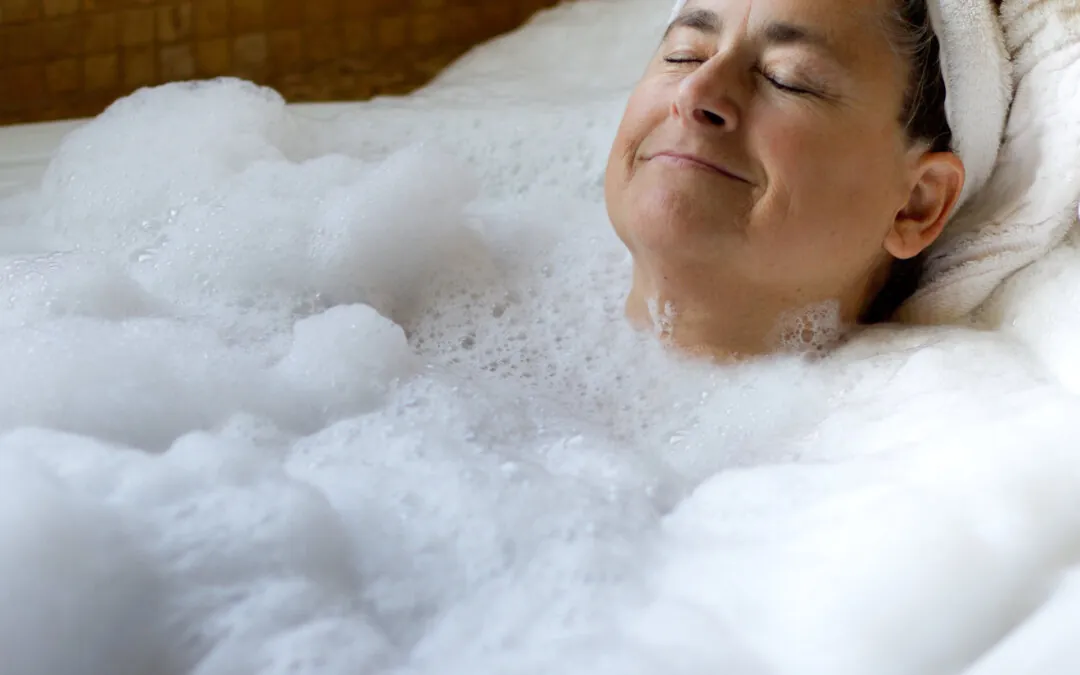
If your muscles feel sore, your first solution might be to soak in a bath to feel relaxed. There’s nothing better than stepping into a nice warm bath and letting your stress melt away.
We all know it feels nice and can help you to relax, but what’s the impact on those aching muscles?
In this article, we’ll discuss the benefits of water therapy for muscle recovery as well as some tricks to keep in mind to get the most out of your baths.
Get a FREE Brochure
Simply complete our form to see a full range of bathing solutions & their key features. It takes no time at all!
- Are baths good for muscle recovery?
- Hot and cold therapy to help with muscle pain
- Advice for cold water therapy
- Advice for hot water therapy
- Don’t have the temperature too hot
- Postures for muscle relaxation
- Different types of bath therapies for different muscle injuries
Are baths good for muscle recovery?
There are many reasons why you should consider baths for muscle relief, over a shower. If you lead an active lifestyle, you might encounter sore muscles as a result of injuries.
For example, when you damage a vertebra, disk or nerve, the muscles surrounding this area have to contract to avoid that part of the body from any further damage. This is your body’s natural response for prevention, but it can leave you with muscle spasms, aches and pains.
There might be other reasons for muscle pain; diseases, arthritis and poor blood circulation are just a few. Whatever the reason for sore muscles, baths can aid with recovery and allow you to feel more agile and less achy.
Hot water can help your muscles to relax and loosen spasms. If you have water jets, a massaging sensation can target the areas and help to loosen tight muscles and stubborn aches.
Increase blood circulation
Heat increases blood flow, allowing essential nutrients and oxygen to reach your muscles. This can improve the connective tissues’ elasticity, helping to release muscle tightness and eliminate pain.
It’s important to note that a hot bath isn’t the answer to an injury, as you’ll need to use this in conjunction with physical therapy. However, as heat encourages your muscles to feel more supple, your muscles will feel more soothed and flexible, increasing recovery time and making movements easier.
Muscle recovery doesn’t take long
You don’t need to soak in the bath for hours every day to relish in its benefits; no more than 15 minutes is enough to have a positive effect on your muscles.
Hot and cold therapy to help with muscle pain
The physiological effects of ice and hot baths are different. Ice baths constrict blood vessels, which can help to delay the onset of muscle soreness, which is perfect after vigorous physical activity, such as after a long run.
A lot of athletes use ice baths to recover after exercise. However, the research on their benefits is limited. Some research suggests cold water therapy might help to reduce delayed onset muscle soreness (DOMS).
DOMS occurs when lactic acid builds up in muscles through blood vessels, so soaking in cold (preferably icy) water can constrict your blood vessels and increase blood circulation, allowing your muscles to clear away any waste products.
Advice for cold water therapy
Inflammation is a natural aftermath of exercising and recovery, but if you overdo physical activity, you may encounter excess inflammation, which could lead to an overuse injury. Cold water can stop this process, leading to a reduced risk of muscle injury and soreness.
However, we suggest approaching ice baths with caution. Do not attempt one unless you’ve spoken to a medical professional first as they can worsen some medical conditions.
Cold water therapy isn’t suitable for those with high blood pressure, particularly autoimmune conditions and heart conditions. If you have any other health concerns, check with your doctor first. Children and pregnant women should also avoid cold water therapy. Dunking in icy water is a huge shock to the system and it shouldn’t be taken lightly.
On the other hand, hot baths increase blood flow to your muscles by expanding blood vessels, which is what your body needs after exercise. When any muscle pain and aches have been reduced, a hot bath is perfect for increasing circulation, which helps with muscle recovery and healing.
Advice for hot water therapy
Some people might believe that a warm bath will cause inflammation when it can actually be one of the best cures for soreness and injuries.
Instead of applying a hot compress to the area of your body that’s painful, a bath filled with hot water provides deep heat across the entire muscle for even distribution. You may also wish to place a small ball underneath the painful area and roll your body across it for a gentle massage underwater.
When you indulge in a hot bath, make sure you remain hydrated while you’re bathing, so take a glass of water into the bathroom with you. Heat can cause dehydration and contribute to water loss, which can worsen muscle soreness, so make sure to replenish any fluids lost.
If you have muscle inflammation or an injury, don’t engage in heat therapy for a minimum of two days. After this time has passed, you can soak in hot water to help your muscles recover and relax to encourage a range of motion.
Don’t have the temperature too hot
Have you ever felt dizzy and slightly faint after getting out of a hot bath? That’s an indication that the temperature was too hot, and your blood pressure has dropped.
The water shouldn’t be so hot that it’s scolding and leaves red marks on your body. This can actually have the opposite effect of relaxing your muscles and mind.
Hot baths are renowned for helping you to relax, though you shouldn’t get straight into a hot bath after exercising, so wait until the next day when your muscles begin to ache from a workout.
Instead, opt for cold water therapy first to prevent muscle soreness in the first place. When it’s time for a hot bath, add some salts and/or a soothing bubble bath to add further muscle-relaxing benefits.
Postures for muscle relaxation
Utilise water therapy to experience maximum advantages across all areas of your body with these recommended postures and positions.
Different types of bath therapies for different muscle injuries
There are many types of hydrotherapy, each with its own set of benefits and intended purposes. Here are the different categories of bath therapies:
- Aromatherapy
- An aromatherapy bath can offer relief from muscle pains and tension. Some recommendations: peppermint essential oil, Eucalyptus essential oil, lavender essential oil and more.
- Mud bath
- Mud baths are filled with mineral-rich ingredients to improve muscle recovery. Consider magnesium to ease muscle pain.
- Hydrotherapy
- Hydrotherapy jets relieve muscle soreness and tightness by removing lactic acid from muscles.
- Thalassotherapy
- This bath therapy reduces muscle tightness and inflammation by increasing blood circulation and, therefore, removing toxins.
- Steam bath
- Steam baths increase blood flow to muscles to relieve pain and muscle damage. Engage in this type of bath therapy immediately after exercising to assist with post-workout recovery.
- Hot spring
- Hot water eases muscle soreness and increases oxygen and blood circulation, so your muscles have all the nutrients they require to recover.
- Balneotherapy
- The thermal mechanism of water stimulates circulation and reduces inflammation, allowing your muscles to recover quicker. The pressure of the water stimulates nerves and causes the muscles (and brain) to relax.
- Contrast bath therapy
- This type of therapy involves immediately switching between hot and cold water immediately following an intense workout to treat painful muscles and injuries.
- Immersion bath
- This involves submerging in icy cold water to assist with muscle soreness and speed recovery.
Conclusion
Baths shouldn’t be a replacement for recovery solutions, such as foam rolling and undergoing thorough warm-ups and cool-downs, but they can provide additional support if you’re struggling with muscle fatigue or pain.
Plus, as we mentioned initially, they simply feel good. It’s often helpful to see how your body feels and adapt accordingly because everyone is different.
For many people, baths can help relieve pain and speed up recovery after exercise. However, if you’ve got an injury, you’ll need to see a GP or physio and seek medical advice on the best course of action.
Speak to us today about our mobility bathing solutions, including walk-in showers, walk-in baths and wet rooms.






